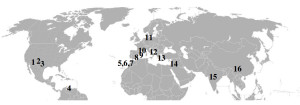New paper: Kepler Object of Interest Network

The first paper about this project is now accepted:
“Kepler Object of Interest Network I. First results combining ground and space-based observations of Kepler systems with transit timing variations”
During its four years of photometric observations, the Kepler space telescope detected thousands of exoplanets and exoplanet candidates. One of Kepler’s greatest heritages has been the confirmation and characterization of hundreds of multi-planet systems via Transit Timing Variations (TTVs). However, there are many interesting candidate systems displaying TTVs on such long time scales that the existing Kepler observations are of insufficient length to confirm and characterize them by means of this technique. To continue with Kepler’s unique work we have organized the “Kepler Object of Interest Network” (KOINet). The goals of KOINet are, among others, to complete the TTV curves of systems where Kepler did not cover the interaction timescales well. KOINet has been operational since March, 2014. Here we show some promising first results obtained from analyzing seven primary transits of KOI-0410.01, KOI-0525.01, KOI-0760.01, and KOI-0902.01 in addition to Kepler data, acquired during the first and second observing seasons of KOINet. While carefully choosing the targets we set demanding constraints about timing precision (at least 1 minute) and photometric precision (as good as 1 part per thousand) that were achieved by means of our observing strategies and data analysis techniques. For KOI-0410.01, new transit data revealed a turn-over of its TTVs. We carried out an in-depth study of the system, that is identified in the NASA’s Data Validation Report as false positive. Among others, we investigated a gravitationally-bound hierarchical triple star system, and a planet-star system. While the simultaneous transit fitting of ground and space-based data allowed for a planet solution, we could not fully reject the three-star scenario. New data, already scheduled in the upcoming 2018 observing season, will set tighter constraints on the nature of the system.
“Kepler Object of Interest Network I. First results combining ground and space-based observations of Kepler systems with transit timing variations”, von Essen, C.; Ofir, A.; Dreizler, S.; Agol, E.; Freudenthal, J.; Hernandez, J.; Wedemeyer, S.; Parkash, V.; Deeg, H. J.; Hoyer, S.; Morris, B. M.; Becker, A. C.; Sun, L.; Gu, S. H.; Herrero, E.; Tal-Or, L.; Poppenhaeger, K.; Mallonn, M.; Albrecht, S.; Khalafinejad, S.; Boumis, P.; Delgado-Correal, C.; Fabrycky, D. C.; Janulis, R.; Lalitha, S.; Liakos, A.; Mikolaitis, S.; Moyano D’Angelo, M. L.; Sokov, E.; Pakstiene, E.; Popov, A.; Krushinsky, V.; Ribas, I.; Rodriguez S., M. M.; Rusov, S.; Sokova, I.; Tautvaisiene, G.; Wang, X., accepted by Astronomy & Astrophysics, 2018.